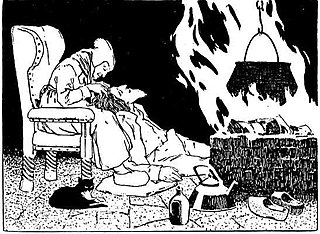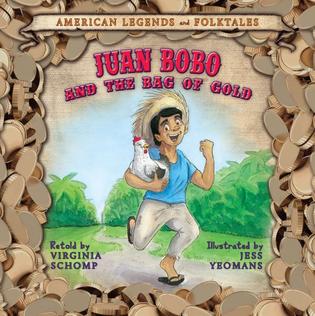
A fairy tale is a short story that belongs to the folklore genre. Such stories typically feature magic, enchantments, and mythical or fanciful beings. In most cultures, there is no clear line separating myth from folk or fairy tale; all these together form the literature of preliterate societies. Fairy tales may be distinguished from other folk narratives such as legends and explicit moral tales, including beast fables. Prevalent elements include dwarfs, dragons, elves, fairies, giants, gnomes, goblins, griffins, mermaids, talking animals, trolls, unicorns, monsters, witches, wizards, and magic and enchantments.

"Beauty and the Beast" is a fairy tale written by French novelist Gabrielle-Suzanne Barbot de Villeneuve and published in 1740 in La Jeune Américaine et les contes marins. Her lengthy version was abridged, rewritten, and published by French novelist Jeanne-Marie Leprince de Beaumont in 1756 in Magasin des enfants to produce the version most commonly retold. Later, Andrew Lang retold the story in Blue Fairy Book, a part of the Fairy Book series, in 1889. The fairy tale was influenced by Ancient Greek stories such as "Cupid and Psyche" from The Golden Ass, written by Lucius Apuleius Madaurensis in the second century AD, and "The Pig King", an Italian fairytale published by Giovanni Francesco Straparola in The Facetious Nights of Straparola around 1550.

The Frog Princess is a fairy tale that has multiple versions with various origins. It is classified as type 402, the animal bride, in the Aarne–Thompson index. Another tale of this type is the Norwegian Doll i' the Grass. Eastern European variants include the Frog Princess or Tsarevna Frog and also Vasilisa the Wise ; Alexander Afanasyev collected variants in his Narodnye russkie skazki, a collection which included folk tales from Ukraine and Belarus alongside Russian tales.
Cuento is a Spanish word meaning literally "story" or "tale". Cuento may specifically refer to folk tales, a category of folklore that includes stories passed down through oral tradition. The word cuento may also be used as a verb to say "tell", as if you are "telling" a story ("Cuento").

"The Three Spinners" is a German fairy tale collected by the Brothers Grimm in Grimm's Fairy Tales. It is Aarne–Thompson type 501, which is widespread throughout Europe.

The Story of Pretty Goldilocks or The Beauty with Golden Hair is a French literary fairy tale written by Madame d'Aulnoy. Andrew Lang included it in The Blue Fairy Book.

Jean de l'Ours or John the Bear, John of the Bear, John-of-the-Bear, John Bear, is the leading character in the French folktale Jean de l'Ours classed as Type 301B in the Aarne–Thompson system; it can also denote any tale of this type.

"The Devil with the Three Golden Hairs" is a German fairy tale collected by the Brothers Grimm. It falls under Aarne–Thompson classification types 461, and 930.

"The Brave Little Tailor" or "The Valiant Little Tailor" or "The Gallant Tailor" is a German fairy tale collected by the Brothers Grimm. "The Brave Little Tailor" is a story of Aarne–Thompson Type 1640, with individual episodes classified in other story types.
The Bird of Truth is a Spanish fairy tale collected by Cecilia Böhl de Faber in her Cuentos de encantamiento. Andrew Lang included it in The Orange Fairy Book.

Pura Teresa Belpré y Nogueras was an Afro-Puerto Rican educator who served as the first Puerto Rican librarian in New York City. She was also a writer, collector of folktales, and puppeteer.

The Knights of the Fish is a Spanish fairy tale collected by Fernán Caballero in Cuentos. Oraciones y Adivinas. Andrew Lang included it in The Brown Fairy Book. A translation was published in Golden Rod Fairy Book. Another version of the tale appears in A Book of Enchantments and Curses by Ruth Manning-Sanders.
Folklore of Spain encompasses the folklore, folktales, oral traditions, and (urban) legends of Spain.
Lulu Delacre is the author/illustrator of many award winning children's books. Some of her most famous works include Arroz con leche: Popular Songs and Rhymes from Latin America, Vejigante Masquerader, and The Bossy Gallito. Delacre's writes books that celebrate her Latino heritage and promote cultural diversity.
Joseph (Joe) Hayes is an American author and teller of stories mainly found in the folklore of the American Southwest. Hayes was an early pioneer of bilingual Spanish/English storytelling. Joe currently lives in Santa Fe, New Mexico.

El Ratoncito Pérez or Ratón Pérez is a fantasy figure of early childhood in Spanish and Hispanic American cultures. The folklore states that when children lose one of their milk teeth, they should place it underneath their pillow or on their bedside table and he will visit while they sleep, replacing the lost tooth with a small payment or gift, as does the Tooth Fairy in other cultures. Although he first appeared in oral tradition folktales such as The Vain Little Mouse, it was Luis Coloma who in 1894 turned him into a tooth dealer in a tale written for an eight-year-old King Alfonso XIII.

Alma Flor Ada is a Cuban-American author of children's books, poetry, and novels. A Professor Emerita at the University of San Francisco, she is recognized for her work promoting bilingual and multicultural education in the United States.

Juan Bobo is a comic book series of folk stories from Puerto Rico, centered on the Juan Bobo children's character. For centuries, these folk stories have been passed from generation to generation amongst Puerto Rican schoolchildren, and the Juan Bobo comic books have been published in Puerto Rico, the United States and Spain, among other countries. For nearly two centuries a vast collection of books, songs, riddles and folktales have developed around the Juan Bobo character. Hundreds of children's books have been written about Juan Bobo in English and Spanish. There are at least 70 Juan Bobo stories. In 2002, the book Juan Bobo Goes to Work won the ALA Notable Books for Children Award and the Belpré Medal for its illustrations.
The Calumniated Wife is a motif in traditional narratives, numbered K2110.1 in Stith Thompson's Motif-Index of Folk-Literature. It entails a wife being falsely accused of, and often punished for, some crime or sin. This motif is at the centre of a number of traditional plots, being associated with tale-types 705–712 in the Aarne–Thompson–Uther Index of tale-types.
The Bird that Spoke the Truth is a New Mexican folktale. It is related to the motif of the calumniated wife and classified in the international Aarne-Thompson-Uther Index as type ATU 707, "The Three Golden Children".












